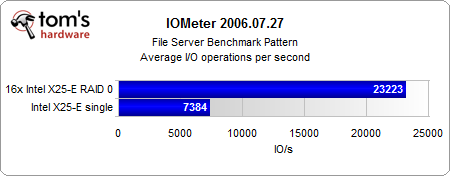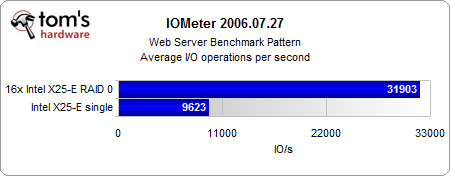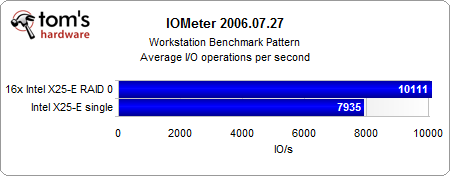Breaking Records With SSDs: 16 Intel X25-Es Do 2.2 GB/s
Benchmark Results: I/O Performance
Keep in mind that I/O performance isn’t just limited by the amount of drives but also by the RAID controller and the host system, which has to support a maximum amount of I/O operations per second. In this case, a faster processor would speed up I/O performance even more. The Core i7 920 platform we used isn’t necessarily the best choice, yet we received respectable results.
IOMeter Profile Overview
| Header Cell - Column 0 | Read | Random | Block Size | Workers |
|---|---|---|---|---|
| Database | 67% | 100% | 8 KB – 100% | 4 |
| File server | 80% | 100% | 512 Bytes – 10%1 KB – 5%2 KB – 5%4 KB – 60%8 KB – 2%16 KB – 4%32 KB – 4%64 KB - 10% | 4 |
| Web server | 100% | 100% | 512 Bytes – 22%1 KB – 15%2 KB – 8%4 KB – 23%8 KB – 15%16 KB – 2%32 KB - 6%64 KB – 7%128 KB – 1%512 KB - 1% | 4 |
| Workstation | 80% | 80% | 8 KB – 100% | 4 |
| Streaming Writes | 100% | 0% | 64 KB – 34%128 KB – 33%256 KB 33% | 4 |
| Streaming Reads | 0% | 0% | 64 KB – 34%128 KB – 33%256 KB - 33% | 4 |
| Row 6 - Cell 0 | Row 6 - Cell 1 | Row 6 - Cell 2 | Row 6 - Cell 3 | Row 6 - Cell 4 |
Database access, which is based on 8 KB block size, 100% random operation, and 67% read operation, delivers 5.6x more performance on the massive 16-drive array than on an individual drive within our system configuration.
The file server profile is based on 100% random access and 80% read operation but various block sizes. The benefit for the massive flash SSD array is a 3.1x performance boost.
Our Web server test is based on 100% random operation and 100% reads at small block sizes typical for small graphics or HTML files. The performance jump is 3.3x.
Overall, it is obvious that a much smaller number of flash SSDs is already sufficient to saturate our test system with four worker threads. Higher I/O performance is most likely possible once you go for a dual quad-core processor system. This would allow one to run eight workers as in Samsung’s project. However, the Samsung guys did not publish I/O performance numbers, so let’s move on to throughput.
Get Tom's Hardware's best news and in-depth reviews, straight to your inbox.
Current page: Benchmark Results: I/O Performance
Prev Page Test Setup Table Next Page Benchmark Results: Throughput


